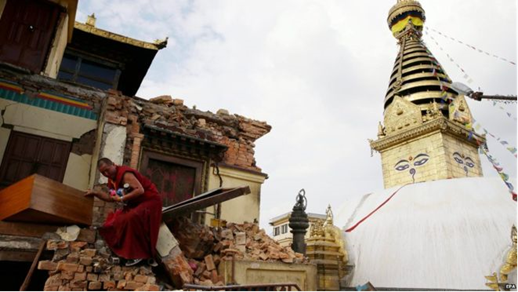The KSBs on Disaster Risk Management Analytics and Solutions (D-RAS) & Culture, Heritage, and Sustainable Development present:
Strengthening of Historic Buildings: Increasing Resilience or Losing Value
Wednesday, November 11, 2015 || 12:30 - 2:00 pm || Room I 2-220
Description:
In the aftermath of a natural disaster such as an earthquake, governments often find they do not have adequate technical, legal, or financial tools needed to implement a robust reconstruction program. More than this, they may even lack the necessary knowledge. This is particularly true of cultural assets such as historical buildings. For TTLs and other stakeholders, it also raises important questions such as:
Which parts of physical buildings hold cultural/historical/aesthetic value, should those be preserved/repaired/restored, and critically, how?
Should authenticity always be the main concern?
When considering historic buildings, is the pace of the reconstruction just as important as the modality?
Thirty years after the recommendations for repairing and strengthening historic buildings were presented at International Council of Monuments and Sites (ICOMOS) General Assembly, this timely BBL evaluates the approach to "reconstruction" of historic buildings with reference to recent destructive seismic events worldwide, where historic buildings have been seriously affected. Specifically the BBL addresses:
the traditional and more innovative procedures used for the reconstruction of historical buildings and monuments,
the question of whether there is a common understanding between the conservation and the seismic engineering community, and
whether and how lessons from past failures are informing new strengthening strategies.
We invite you to join us to find these answers that also have direct implications for the Building Back Better approach undertaken by the Disaster Risk Management (DRM) community and the World Bank, and more broadly, for cultural tourism and the empowerment of local communities.
Chair:
Catalina Marulanda, Lead Urban Specialist and Acting Practice Manager, GSURR
Presenter:
Prof. Dina D’Ayala, Department of Civil Environmental and Geomatic Engineering, University College London
Discussant:
Ahmed Eiweida, Lead Urban Specialist, GSURR
Professor Dina D'Ayala is Head of Civil Engineering and Co-director of the EPICentre research centre. She is a structural engineer with a humanities background and her research focus is the protection of architectural heritage and urban settlements from natural hazard. Previously at University of Bath, she headed the Earthquake and Conservation Engineering Research group for 15 years. Recent interdisciplinary research encompasses the numerical analysis and design of retrofit intervention for adobe heritage in South America, the development of seismic analytical vulnerability functions for low and none engineered buildings worldwide within the GEM framework, the development of resilient measure to reduce vulnerability to flood and wind driven rain of historic buildings in the UK. In collaboration with industry Dina has developed dissipating device to be use in the retrofitting of historic building to mitigate the effect of seismic action. She is currently supervising research on definition of multi-hazard vulnerability functions for road infrastructures, the definition of fragility function for masonry infill steel frames and research into the effect of strengthening on seismic capacity and vulnerability assessment at territorial level. In collaboration with WB Dina’s is supervising an Eng D research on the relative effect of uncertainties in exposure and vulnerability on determining seismic risk in urban areas of Central America.
Dina is an EERI member, a SECED member and a member of the EEFIT team. She is associate editor of the Bulletin of Earthquake Engineering, and member of the editorial board of the International Journal for Architectural Heritage. She has been a consultant to the WB, IDA, UNDP and UNESCO on projects of heritage conservation and hazard protection in the Middle East, Ethiopia, Turkey, Iraq, Nepal etc.
Calendar » Strengthening of Historic Buildings Increasing Resilience or Losing Value
Strengthening of Historic Buildings Increasing Resilience or Losing Value
The KSBs on Disaster Risk Management Analytics and Solutions (D-RAS) & Culture, Heritage, and Sustainable Development present:
Strengthening of Historic Buildings: Increasing Resilience or Losing Value
Wednesday, November 11, 2015 || 12:30 - 2:00 pm || Room I 2-220
Description:
In the aftermath of a natural disaster such as an earthquake, governments often find they do not have adequate technical, legal, or financial tools needed to implement a robust reconstruction program. More than this, they may even lack the necessary knowledge. This is particularly true of cultural assets such as historical buildings. For TTLs and other stakeholders, it also raises important questions such as:
Thirty years after the recommendations for repairing and strengthening historic buildings were presented at International Council of Monuments and Sites (ICOMOS) General Assembly, this timely BBL evaluates the approach to "reconstruction" of historic buildings with reference to recent destructive seismic events worldwide, where historic buildings have been seriously affected. Specifically the BBL addresses:
We invite you to join us to find these answers that also have direct implications for the Building Back Better approach undertaken by the Disaster Risk Management (DRM) community and the World Bank, and more broadly, for cultural tourism and the empowerment of local communities.
Chair:
Catalina Marulanda, Lead Urban Specialist and Acting Practice Manager, GSURR
Presenter:
Discussant:
Ahmed Eiweida, Lead Urban Specialist, GSURR
Dina is an EERI member, a SECED member and a member of the EEFIT team. She is associate editor of the Bulletin of Earthquake Engineering, and member of the editorial board of the International Journal for Architectural Heritage. She has been a consultant to the WB, IDA, UNDP and UNESCO on projects of heritage conservation and hazard protection in the Middle East, Ethiopia, Turkey, Iraq, Nepal etc.